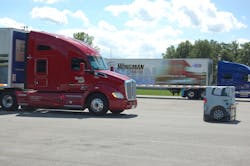Fred Andersky will tell you that one of the overarching goals of safety systems today – from electronic stability control (ESC) to collision mitigation technology – is not only to prevent vehicle crashes but to “downgrade” the crashes that do occur, not only potentially saving lives but lots of money as well.
“You really don’t want to experience any of this technology in real life situations; if you do, it means something went terribly wrong, that you’ve mucked up really bad,” he told Fleet Owner during a safety system demonstration event held jointly by United Parcel Service (UPS) and Bendix Commercial Vehicle Systems in Norwalk, OH, this week.
Andersky – director of customer solutions and government affairs for Bendix – also stressed that the impact of crashes on truck drivers in particular goes far beyond any immediate damages that occur, he stressed, particularly under the Compliance Safety Accountability (CSA) program.
“Rollovers and crashes don’t just affect lives and property; under CSA, they directly affect the driver’s livelihood as well,” he noted – thus why safety technology, if it can’t fully prevent a crash, is designed to help lessen its severity and thus lessen its impact on lives, limbs, sheet metal, and livelihoods.
[Below are some examples of the testing conducted during the UPS/Bendix event.]
For example, Andersky pointed out that in 2013 the average property claim for a truck-involved crash totaled $63,000, with a crash resulting in an injury costing $438,000. In the case of a truck-involved crash fatality, however, the costs soared to $10.9 million.
Thus if safety technology can help downgrade crash severity – taking one of the 3,541 truck-involved crash fatalities that occurred in 2013 and changing them into one of the 69,000 truck-involved crash injuries or 254,000 cases where only property damage resulted in a truck-involved crash – not only are more human lives potentially saved but the bottom line impact of motor carriers is significantly reduced as well.
As an example, Andersky highlighted one of the test runs conducted at the event by a reporter at the wheel of Bendix test tractor-trailer loaded to 78,000 lbs. and equipped with its Wingman Fusion collision mitigation package.Approaching a target dummy substituting for a parked car at 50 mph without using the brakes, the reporter jerked the tractor-trailer’s steering wheel in the last few seconds, causing the system’s “emergency braking” feature to disengage – thus allowing the truck to bump the target at one or two mph, moving it forward about three feet.
“We’ve designed our collision mitigation technology to be a driver assistance system, not a driver replacement system,” Andersky noted. Thus, he explained, when the system detected the driver turning the steering wheel, it disengaged to allow for maneuvering.
And when that maneuvering did not happen, leaving the truck aimed at the target and thus making a crash still imminent, the Wingman system re-engaged at the last second to activate the brakes and minimize the crash impact.
That would make a huge difference in real life, Andersky stressed.
“It’s the difference between a family getting out of their car – uninjured – to see how badly their rear bumped is damaged, or dialing 911 for an ambulance,” he said. “That’s how you know the technology did its job.”
About the Author
Sean Kilcarr
Editor in Chief
Sean Kilcarr is a former longtime FleetOwner senior editor who wrote for the publication from 2000 to 2018. He served as editor-in-chief from 2017 to 2018.

